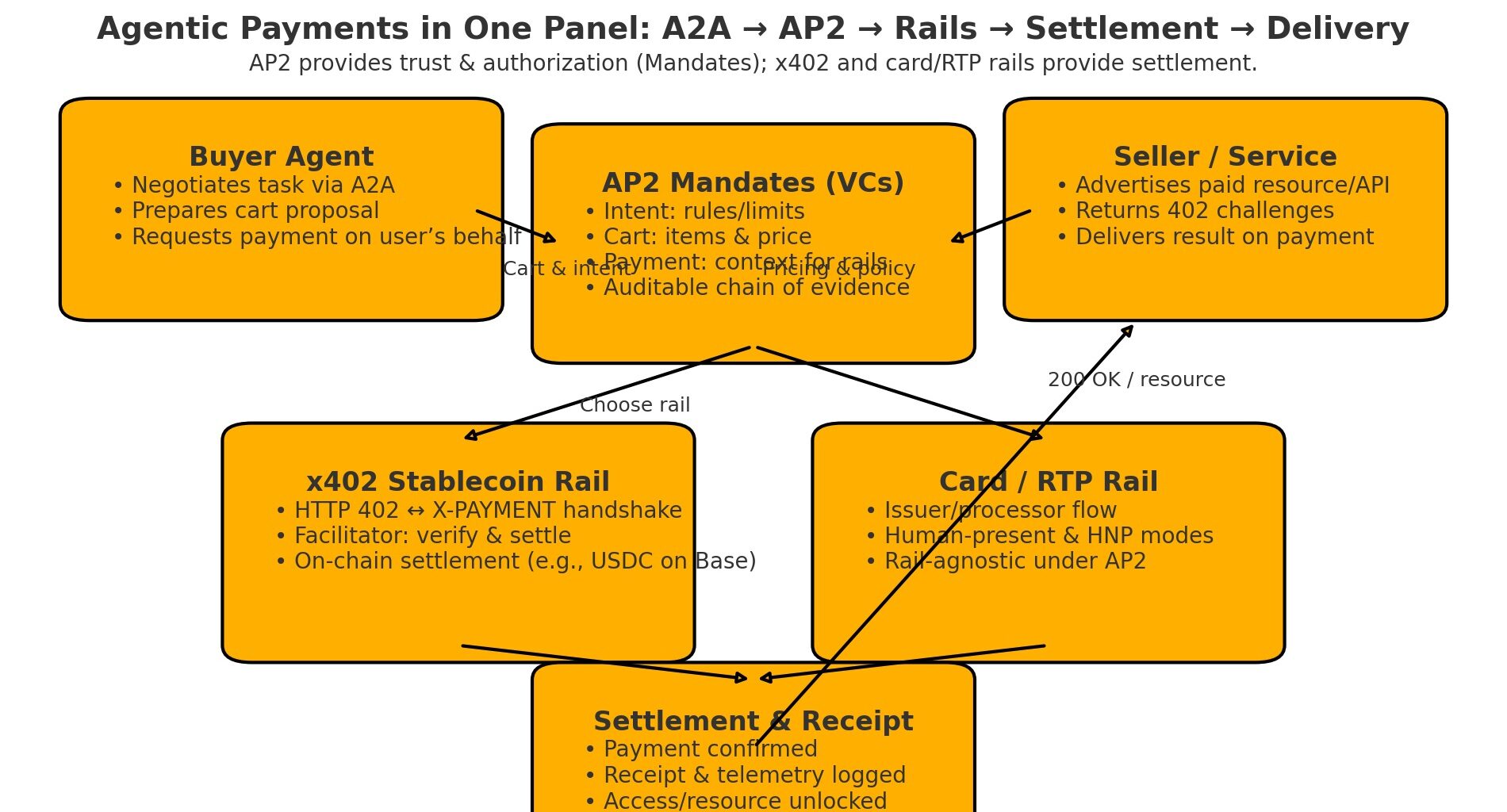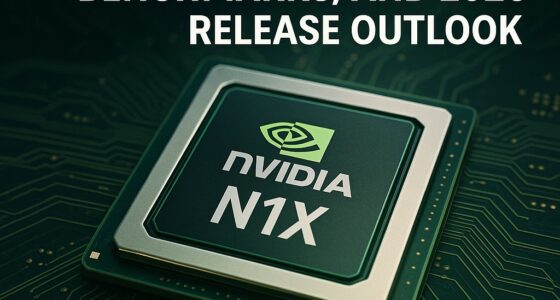Executive brief (what changed, why it matters)
On September 16, 2025, Google introduced the Agent Payments Protocol (AP2)—an open way for AI agents to prove they’re allowed to pay, across any payment rail (cards today; real‑time transfers and stablecoins in scope). AP2 centers on Mandates—tamper‑resistant, verifiable credentials (VCs) that capture user Intent, the approved Cart, and the Payment context, producing a non‑repudiable audit trail. Google says 60+ organizations (networks, processors, wallets, fintechs) are collaborating. Google Cloud
Coinbase’s x402 is the complementary settlement rail for web‑native, per‑request payments. It revives HTTP 402 Payment Required so a server can challenge a request, receive a signed payment in a header, and confirm via a facilitator—today offering fee‑free USDC settlement on Base (managed by Coinbase’s facilitator). Coinbase Developer Docs+2Coinbase Developer Docs+2
Taken together, AP2 (trust & authorization) + x402 (execution & settlement) make agent‑to‑agent commerce practical—not just for shopping carts, but for pay‑per‑use APIs, data, and micro‑tasks that your software already consumes or sells. Google Cloud+1
Plain‑English architecture (so you can map it to your business)
- A2A: Open protocol (Linux Foundation) that lets agents from different vendors talk/coordinate. Think: procurement bot ↔ supplier bot. Linux Foundation
- AP2: The trust layer—captures who authorized what, at what price, and under what limits using Verifiable‑Credential Mandates (Intent → Cart → Payment). Works with A2A and MCP. Rail‑agnostic by design. Google Cloud
- x402: The payment layer over HTTP—
402challenge → client replies with signed payment → facilitator verifies/settles (e.g., USDC on Base). Supports EIP‑3009 signature‑based flows (enabling gasless UX when a facilitator sponsors gas). docs.base.org+3Coinbase Developer Docs+3Coinbase Developer Docs+3
Mental model: AP2 gives merchants and banks the evidence they need; x402 moves the money with low friction.
Business impact by function
1) Revenue & product
- Monetize the “long tail” with micropayments. Package capabilities you currently bundle (e.g., exports, enrichment, reports, webhooks) as per‑request, per‑document, per‑crawl endpoints. Agents can discover and pay on demand instead of negotiating subscriptions. Coinbase Developer Docs
- Open a new channel: agents as customers. With AP2 Mandates, counterparties can accept agent‑originated orders without guessing intent, which makes it safer to sell to autonomous clients. Google Cloud
- Dynamic marketplaces. Coinbase’s x402 Bazaar lists payable endpoints for agents to discover programmatically; early placement compounds distribution. Coinbase Developer Docs+1
2) Finance & risk
- Cleaner dispute posture. AP2’s VC chain ties a payment to explicit Intent and Cart; that auditability improves how you handle disputes and clawbacks (or the lack thereof on stablecoin rails). Google Cloud
- Lower chargeback exposure for on‑chain flows. Stablecoin settlement is typically final; design refund policies accordingly and push more checks into Mandate capture. Coinbase Developer Docs
- New KPIs: auth‑to‑settlement latency,
402error/retry rates, dispute ratio by mandate class (human‑present vs delegated). (KPIs are operational guidance; settle‑flow mechanics per x402 docs.) Coinbase Developer Docs
3) Engineering & ops
- Less billing plumbing. x402’s facilitator verifies/settles so sellers don’t run nodes or craft transactions; you add a
402challenge and receipt headers. Coinbase Developer Docs+1 - Interoperability path. A2A’s Linux Foundation stewardship reduces vendor lock‑in; AP2 is open and multi‑rail, so you can start on cards and add stablecoins later without re‑writing your trust layer. Linux Foundation+1
Where the first‑mover advantage is real
- Being discoverable first. Listing your service(s) in x402 Bazaar makes you a default building block for autonomous workflows. Agents (and rival platforms) will route to what they can find. Early entries become de facto standards. Coinbase Developer Docs
- Owning high‑intent, moment‑of‑need purchases. Delegated AP2 Intent Mandates (e.g., “buy tickets the second they drop if ≤$120”) convert fleeting demand spikes you cannot capture via human checkout funnels. Google Cloud
- Capturing per‑request economics. Many features are undervalued inside bundles. A pay‑per‑use price that looks tiny to a human can be normal for agents calling thousands of times/day. Early adopters set category pricing and usage norms.
- Data advantage. Instrument
402challenges, approval rates by Mandate class, and settlement times. Those traces become a proprietary signal on what agents buy and when—useful for forecasting and dynamic pricing. - Partnership gravity. AP2 is launching with 60+ collaborators (networks, processors, wallets). Showing a credible AP2/x402 roadmap positions you for early inclusion in marketplaces and case studies. Google Cloud
Risks & realism (with mitigations)
- Latency vs. finality. Marketing around x402 mentions sub‑second acknowledgments (e.g., “~200 ms”). Treat that as UX speed, not guaranteed economic finality under all loads. For high‑value goods, require stricter confirmations before delivery. Instrument p50/p95 auth‑to‑delivery. Yahoo Finance
Mitigate: differentiate soft‑unlock (preview data, low value) vs hard‑deliverables (models, licenses) by value threshold. - Agent misbehavior & prompt injection. AP2 clarifies who approved what; it doesn’t prevent a compromised agent from shopping incorrectly.
Mitigate: least‑privilege Mandate scopes, ceilings, expiries; strong UI binding for Cart presentation; domain pinning; audit logs. Google Cloud - Compliance spread. On‑chain rails remove chargebacks and introduce KYT/OFAC screens in the facilitator and your own policies.
Mitigate: capture KYC/AML posture proportional to purchase size and region; keep clear refund workflows; map Mandate types to spend tiers. - Change management. Sales/finance ops need new SKUs, tax handling for micro‑sales, and revenue recognition for per‑request items.
Mitigate: start with one micro‑SKU and expand.
Build‑or‑buy quick guide
| Decision | When to choose | Notes |
|---|---|---|
| Use Coinbase’s x402 facilitator | You want fastest path to USDC on Base with minimal infra | Managed verify/settle; “fee‑free USDC on Base” at launch. Coinbase Developer Docs |
| Self‑host / third‑party facilitator | You need custom networks, tokens, or in‑house controls | Protocol & reference servers are open; interfaces: /verify, /settle. GitHub |
| Start card‑only with AP2 | Your finance team prefers familiar rails first | Keep AP2 Mandates; you can add x402 later without changing the trust model. Google Cloud |
Two‑track rollout you can start this quarter
Track A — Add AP2 to an existing checkout (cards)
- Pick a high‑intent flow (renewal add‑on, dynamic bundle).
- Capture Mandates:
- Intent Mandate when the user tasks your agent (with spend ceiling).
- Cart Mandate when the agent proposes a basket (items & price).
- Payment Mandate as you hand off to the rail. Google Cloud
- Measure: approval rate, disputes per 1,000 orders vs. your standard checkout.
Track B — Wrap one API behind x402 (stablecoins)
- Choose a micro‑API (e.g., “extract table from URL” or “clean CSV”).
- Return HTTP 402 with price, asset, network, and recipient; on resubmission, read
X‑PAYMENT, call a facilitator to verify/settle, then return200+ content. Coinbase Developer Docs+1 - List it in x402 Bazaar using the discoverable flag to appear in the catalog agents query. Coinbase Developer Docs
Tip: If you orchestrate multiple services, put A2A at the top, AP2 around checkout/authorization, and use x402 selectively for machine‑friendly, low‑value, high‑frequency items. Linux Foundation+1
ROI model (sanity check)
Assume you expose a paid endpoint that your product already performs internally:
- Price: $0.05 per request
- Daily volume: 40,000 agent calls (across customers + external agents)
- Monthly revenue: ~$60,000
- Infra cost: $8,000 (compute + facilitator overhead)
- Gross margin: ~87%
Even at 1/10th the volume, such a wedge can add a meaningful, low‑churn revenue stream and a new top‑of‑funnel for your core product (agents that “buy first, evaluate later”).
Who should move first (industry lenses)
- SaaS & DevTools: expose functions like formatting, enrichment, linting, test‑runs as x402‑paid micro‑APIs; price per run; route complex orders through AP2. Coinbase Developer Docs
- Data/Media: sell per‑asset access (vector search, news scrape, historical dataset slices) with
402; provide AP2 receipts for enterprise compliance. Google Cloud - eCommerce/Retail: pilot agent‑led back‑in‑stock purchases or negotiated bundles where human‑present cart approval signs the Cart Mandate. Google Cloud
- Marketplaces/B2B procurement: let buyer agents place small, rule‑constrained orders autonomously; suppliers publish A2A agents + AP2 Mandates; settle either on cards or x402. Linux Foundation
- APIs you already sell: add x402 alongside keys/subscriptions; let agents buy a single call right now.
Governance & ecosystem confidence (why this isn’t vendor lock‑in)
- A2A under the Linux Foundation (June 23, 2025) → neutral stewardship for cross‑vendor agents. Linux Foundation
- AP2 is open and multi‑rail (cards, real‑time, stablecoins), with public documentation and a call for collaborators; Google highlights 60+ partners at launch. Google Cloud
- x402 is open with docs, reference implementations, and facilitator interfaces; Coinbase runs a managed facilitator but others can exist (or you can self‑host). Coinbase Developer Docs+2Coinbase Developer Docs+2
Implementation checklist (30‑60‑90 days)
0–30 days
- Form a tiger team (PM + eng lead + finops + risk).
- Select one micro‑API and implement x402; publish to Bazaar. Coinbase Developer Docs
- Add AP2 Mandate capture to one human‑present flow (cards). Google Cloud
31–60 days
- Add Mandate policies (ceilings, expiries, allow‑lists).
- Define refund and exception paths for on‑chain settlements.
- Instrument KPIs:
402retry rate, auth‑to‑delivery p50/p95, disputes by mandate class.
61–90 days
- Expand to a delegated (human‑not‑present) use case with tight Intent rules. Google Cloud
- Evaluate facilitator options (managed vs self‑host) and card + stablecoin side‑by‑side economics. Coinbase Developer Docs+1
- Draft procurement templates for agent‑as‑customer terms (Mandate scope, SLAs, telemetry).
A note on speed claims
You may see headlines claiming “AI agents can now pay APIs with USDC in ~200 ms.” Treat this as an ambition for end‑to‑end acknowledgment rather than a universal finality guarantee; your risk policy should decide when to deliver. Measure real‑world performance against your own SLAs. Yahoo Finance
Bottom line
- AP2 provides the evidence layer that makes agent‑led checkout acceptable to merchants, issuers, and auditors.
- x402 provides the rail that lets agents actually pay—ideal for pay‑per‑use and micro‑transactions.
- Businesses that move first—by listing payable capabilities, instrumenting the Mandate chain, and tuning policies—will set pricing norms, accumulate usage data moats, and become the default choices for agents discovering services. Google Cloud+1
Sources (primary)
- Google Cloud Blog: “Powering AI commerce with the new Agent Payments Protocol (AP2)” (Sept 16, 2025). Mandates (Intent/Cart/Payment), multi‑rail design, A2A/MCP context, 60+ collaborators, A2A x402 extension. Google Cloud
- x402 Docs: HTTP 402 flow, Facilitator (verify/settle), Welcome (managed facilitator; fee‑free USDC on Base), Network Support (EIP‑3009). Coinbase Developer Docs+3Coinbase Developer Docs+3Coinbase Developer Docs+3
- Linux Foundation: A2A project announcement (June 23, 2025). Linux Foundation
- Coinbase Launch Note: “Google Agentic Payments Protocol + x402” (context and Lowe’s demo). Coinbase
- x402 Bazaar docs & launch post (discovery layer for payable endpoints). Coinbase Developer Docs+1









